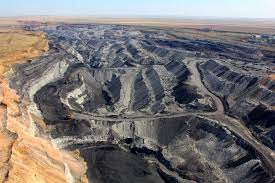Up until the end of last year, the tranquil port of Mtwara in Tanzania mostly traded cashew nuts. As a result of Russia’s invasion of Ukraine, there is now a worldwide scramble for polluting fuel, and the port is bustling with ships filling up with coal.
Tanzania typically only exports thermal coal to its neighbors in east Africa; doing so would require shipping the material more than 600 kilometers from mines in the southwest of the country to Mtwara, the closest Indian Ocean port.
The crushing energy crisis in Europe has altered all of that.
The war has caused thermal coal prices to soar to record highs, which has resulted in several European countries losing access to crucial supplies of natural gas and coal from their primary supplier Russia. Thermal coal is used to produce energy.
Nowadays, buyers from Europe and other regions compete to pay top money for coal coming from frequently inaccessible mines in nations like Tanzania, Botswana, and possibly Madagascar. Governments aiming to wean themselves off Russian energy while keeping a lid on power prices are driving a resurgence in coal consumption, which conflicts with climate objectives to move away from the most polluting fossil fuel.
The managing director of coal miner Bluesky Minings, Rizwan Ahmed, stated in Dar es Salaam, Tanzania, “After the Russian war, European players are moving to any region where there is coal.” They are promising to pay really competitive prices.
According to Jan Dieleman, president of Cargill’s ocean transportation division, the commodities trader has seen a noticeable increase in coal shipments into Europe in recent months. In the six months from June to August, the company transported 9 million tonnes of coal globally, up from 7 million a year earlier.
Gas is a more expensive alternative, and Europe is in competition with other purchasers, according to Dieleman. “Europe should have access to coal, and we’ll see very significant flows into Europe from Colombia, South Africa, and even farther afield.”
Some nations with coal resources believe that the opportunity is too excellent to pass up, even if it may be too late if the geopolitical winds change.
On September 16, front-month physical thermal coal at Australia’s Newcastle port, a global benchmark, was trading at $429 a tonne, up from about $176/tonne at this time last year and just below the record high of $483.50 in March.
According to a port official, Mtwara has had 13 vessels load up with coal since it sent out its first coal shipment in November of last year. The most recent was the MV Miss Simona, a bulk carrier with a 34,529-tonne capacity that docked last week, loaded up, and proceeded to France.
According to research from maritime and commodities data platform Shipfix, since the end of June, 57 cargo orders—requests for available vessels—to export Tanzanian coal have been observed on the spot freight market, compared with just two during the same period the previous year.
Research from shipbroker Braemar reveals that global seaborne thermal coal imports increased by more than 9% year over year in July to reach 97.8 million tonnes, the highest level ever. The volume decreased to 89 million tonnes in August, primarily because major producer Australia’s exports were disrupted.
COAL’S LAST HURRAH:
According to Tanzania’s Mining Commission, the country’s output of coal is anticipated to rise by 50% to around 1,364,707 tonnes this year, while exports are anticipated to more than double to approximately 696,773 tonnes.
According to Yahya Semamba, interim executive secretary of the Mining Commission, a government organization, the government is thinking of creating a railway that would connect the coal-producing Ruvuma region to Mtwara in an effort to raise sizable amounts of tax income from this increase in exports.
According to trade data seen by reporters, the Tanzanian miner Ruvuma Coal has already shipped at least 400,000 tonnes of coal via a dealer to nations such as the Netherlands, France, and India since November.
For this story, Ruvuma Coal declined to respond.
With coal at $75 a tonne in late 2020, a coal mine might earn a cash margin of $15 per tonne, according to Rob West, the analyst at consultancy Thunder Said Energy. Some see this as the last gasp for an industry under severe pressure to reduce production. However, the cash margin rose to $235 per ton as prices reached $400 per ton.
According to certain mine executives, like Ahmed from Bluesky, who said his company didn’t already sell through Mtwara but planned to do so and had received requests through customers in Germany, Poland, and Britain, traders in Europe are indeed willing to pay twice the price provided by Asian buyers.
Similar to this, selling coal on the seaborne market in landlocked Botswana used to be unimaginable, with the majority of exports flowing to the neighboring countries of South Africa, Namibia, and Zimbabwe
Morné du Plessis, CEO of coal miner Minergy, based in Botswana, said: “Earlier, the logistics would kill us, but at current prices, we can make this thing work”.
Minergy has dispatched two trains of coal to be exported from the Maputo port in Mozambique and two shipments of approximately 30,000 tonnes each from the Walvis Bay port in Namibia.
Madagascar, an island nation and the biggest supplier of vanilla in the world may join the ranks of recent entrants in the global coal market.
According to Prince Nyati, CEO of one of the companies building a coal project in Madagascar, “the current prices easily support a financial case for coal miners in Madagascar to start exporting coal for the first time in the country’s history.”
Nyati noted that new entrants will need to be prepared to reduce or even stop output if market conditions deteriorate.
COAL HAS BEEN ACCEPTED
According to Braemar’s research, worldwide “deadweight tonne days,” a measurement of shipping levels in terms of fleet utilization and the length of voyages, reached record highs in July as a result of high demand and limited supplies of coal that have redrawn trade routes.
According to data from Indian consultancy Coalmint, thermal coal imports by the European Union from Australia, South Africa, and Indonesia—traditional suppliers of Asian markets—rose more than 11-fold in the four months following Russia’s invasion of Ukraine.
The invasion has compelled EU countries to lessen their reliance on Russian gas, which has decreased its enormous supplies to the area. The EU’s embargo on Russian coal imports has put even more pressure on power plants to find alternate fuel sources.
According to the Brussels-based think tank Bruegel, Russia normally provides 40% of the EU’s natural gas and nearly 70% of the bloc’s thermal coal.
As they attempt to stockpile fuel and revive dormant coal plants in order to get ready for what may be a challenging winter, European nations have temporarily put environmental aspirations on the back burner.
Despite numerous plant closures over the previous three years, strong incentives have increased coal and lignite generation in Europe by 25% from year-ago levels, according to Bank of America analysts.
In the EU, burning more coal could boost CO2 emissions by 1.3% a year if Russian gas supplies are totally stopped, according to energy think-tank Ember. The present ramp-up in thermal coal combustion could put countries on a collision course with aggressive CO2 emissions reduction goals.
The duration of the energy crisis may determine how transitory the adjustment is, according to European governments. In order to guarantee the security of the power supply, Germany is delaying the planned shutdown of a few coal facilities.
The Botswana coal miner Minergy predicts that the coal market would be robust at least through mid-2023, if not beyond. It wants to increase its output capacity by double.
The business claimed that “coal has been accepted as the go-to energy source amid the energy challenges emerging from the war and the negative narrative surrounding coal has been abandoned.”

















